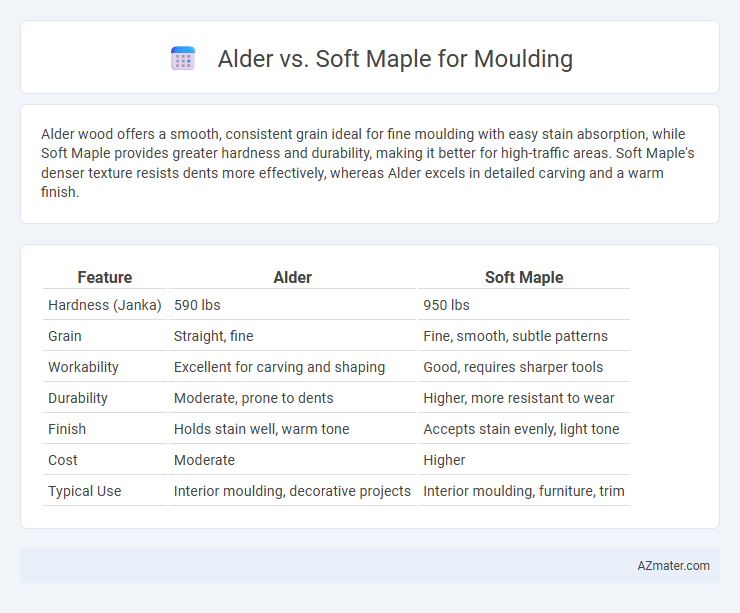Alder wood offers a smooth, consistent grain ideal for fine moulding with easy stain absorption, while Soft Maple provides greater hardness and durability, making it better for high-traffic areas. Soft Maple's denser texture resists dents more effectively, whereas Alder excels in detailed carving and a warm finish.
Table of Comparison
| Feature | Alder | Soft Maple |
|---|---|---|
| Hardness (Janka) | 590 lbs | 950 lbs |
| Grain | Straight, fine | Fine, smooth, subtle patterns |
| Workability | Excellent for carving and shaping | Good, requires sharper tools |
| Durability | Moderate, prone to dents | Higher, more resistant to wear |
| Finish | Holds stain well, warm tone | Accepts stain evenly, light tone |
| Cost | Moderate | Higher |
| Typical Use | Interior moulding, decorative projects | Interior moulding, furniture, trim |
Introduction to Alder and Soft Maple for Moulding
Alder and Soft Maple are popular hardwood choices for moulding due to their workability and aesthetic appeal. Alder offers a fine, uniform texture with a consistent grain pattern that is easy to stain and paint, making it ideal for detailed moulding profiles. Soft Maple provides greater density and strength, featuring a subtle grain variation that holds intricate carvings well, ensuring durability in high-traffic areas.
Wood Characteristics: Alder vs Soft Maple
Alder wood features a fine, straight grain with a smooth texture, resulting in a uniform appearance ideal for detailed moulding work, while Soft Maple offers a slightly harder density and exhibits subtle grain patterns that enhance durability and visual interest. Alder's lighter weight and easier workability make it a preferred choice for intricate designs, whereas Soft Maple's resilience provides superior resistance to dents and wear. Both woods accept stains well, but Alder's consistent grain allows for a more even finish, whereas Soft Maple's variation can create a richer, more natural look.
Durability and Strength Comparison
Soft Maple offers greater hardness and density compared to Alder, making it more durable and resistant to dents and wear in moulding applications. Alder's softer texture provides easier workability but compromises strength and long-term resilience under heavy use. Choosing Soft Maple ensures enhanced structural integrity and longevity for high-traffic or impact-prone moulding installations.
Workability: Cutting, Shaping, and Finishing
Alder offers excellent workability due to its fine, even grain, making it easy to cut, shape, and finish with minimal effort and clean edges for detailed moulding. Soft Maple, while slightly harder than Alder, remains highly workable but may require sharper tools and slower feeds to achieve smooth cuts and intricate shapes. Both woods accept paints and stains well, though Alder's softer nature often results in a smoother finish for moulding projects.
Color and Grain Differences
Alder wood exhibits a warm, reddish-brown hue with a fairly uniform and fine grain, making it ideal for smooth, consistent moulding finishes. Soft maple features a lighter, cream to pale reddish tone with a more pronounced grain pattern that includes subtle streaks and occasional swirls, providing a richer texture in moulding applications. The color and grain differences between alder and soft maple help determine the visual impact and compatibility with surrounding decor in cabinetry and trim projects.
Cost and Availability in the Market
Alder moulding typically offers a lower cost compared to soft maple, making it an economical choice for budget-conscious projects. Soft maple, while slightly more expensive, is widely available in North American markets due to its abundance, ensuring steady supply and variety in grain patterns. Both woods provide good availability, but alder's affordability often makes it more attractive for large-scale moulding applications.
Suitability for Paint and Stain Applications
Alder wood is highly suitable for paint applications due to its smooth grain and uniform texture, which allows for excellent paint adhesion and a flawless finish. Soft Maple, while also capable of holding paint, is better suited for stain applications because its subtle grain patterns absorb stains evenly, enhancing the natural wood appearance. For moulding projects requiring durable paint coverage, Alder is preferred, whereas Soft Maple is ideal when a rich, stained look is desired.
Environmental Impact and Sustainability
Alder wood is often favored for moulding due to its faster growth rate and better carbon sequestration compared to soft maple, making it a more environmentally sustainable choice. Soft maple, while durable, grows more slowly and requires longer harvesting cycles, leading to a higher environmental footprint. Selecting alder for moulding reduces deforestation pressure and supports sustainable forest management practices.
Best Uses for Alder and Soft Maple Moulding
Alder moulding is ideal for interior trim and cabinetry, valued for its smooth grain and excellent staining properties that mimic cherry and mahogany woods. Soft Maple moulding offers superior durability and hardness, making it suitable for high-traffic areas, detailed millwork, and painted finishes due to its ability to hold up well under wear. Both woods provide cost-effective solutions, with Alder preferred for its rich color tones and Soft Maple favored for strength and versatility in residential and commercial moulding projects.
Final Recommendations: Choosing the Right Wood
Soft Maple offers greater durability and resistance to wear, making it ideal for high-traffic areas and long-lasting moulding applications. Alder provides a smoother texture and richer color variations, perfect for decorative mouldings where aesthetic appeal is prioritized. For projects demanding a balance between strength and appearance, Soft Maple is recommended, while Alder suits budget-friendly, visually expressive options.

Infographic: Alder vs Soft Maple for Moulding
 azmater.com
azmater.com